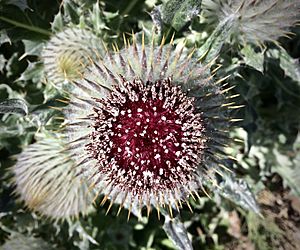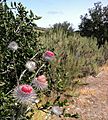Cirsium occidentale facts for kids
Quick facts for kids Cirsium occidentale |
|
|---|---|
 |
|
| Flower head of Cirsium occidentale | |
| Scientific classification | |
| Genus: |
Cirsium
|
| Species: |
occidentale
|
| Synonyms | |
|
Cirsium coulteri |
|
Have you ever seen a plant that looks like it's covered in spiderwebs? That might be the Cobweb Thistle! Its scientific name is Cirsium occidentale. This unique plant is a type of thistle and belongs to the same family as sunflowers, the sunflower family. You can find it growing in North America.
Contents
Where Does the Cobweb Thistle Grow?
The Cobweb Thistle is quite common in many parts of California. It grows in the state's mountain ranges, valleys, and even the Mojave Desert. You can also find it in the western Great Basin area. This includes western Nevada, southern Oregon, and southwestern Idaho.
Unlike some thistles that are introduced from other places and can become a problem, the Cobweb Thistle is a native plant. This means it has always grown here and usually doesn't cause trouble for other plants.
What Does the Cobweb Thistle Look Like?
The Cobweb Thistle is a plant that lives for two years. It starts with a strong main root called a taproot. It can be short, forming small clumps, or it can grow very tall, reaching almost 3 meters (about 10 feet) high!
Its leaves can be dull gray-green or even bright white. This white color comes from a thick coating of hairs. The biggest leaves at the bottom of the plant can be almost half a meter (about 1.5 feet) long. The leaf stems are spiny and have wing-like edges. The leaves themselves are toothed or have triangle-shaped sections.
The Unique Flower Heads
At the top of the whitish stem, you'll find one or more flower heads. Each head is shaped like a sphere. It's covered in large, leaf-like parts called phyllaries. These phyllaries have very long, sharp spines that spread outwards. What makes them special is that they are often covered in fibers that look a lot like cobwebs!
Inside each head, there are many tiny flowers called disc florets. These can be white, blood red, or different shades of purple. The largest flower heads can be bigger than 8 centimeters (about 3 inches) across. The flowers on a single plant don't all open at the same time. This might help them have a better chance of being pollinated by insects.

Who Visits the Cobweb Thistle?
The Cobweb Thistle is an important plant for several types of butterflies. It acts as a "larval host." This means that the caterpillars (larvae) of these butterflies eat the thistle's leaves. Butterflies that use the Cobweb Thistle include the California crescent, the mylitta crescent, and the famous painted lady butterfly.
Different Kinds of Cobweb Thistle
There are several different types, or "varieties," of the Cobweb Thistle. They can look a bit different and grow in various places:
- Cirsium occidentale var. californicum — known as California thistle
- Cirsium occidentale var. candidissimum — called snowy thistle
- Cirsium occidentale var. compactum — known as compact cobwebby thistle. This one is shorter and grows in clumps. It's only found along the coast of the San Francisco Bay Area and the Central Coast of California.
- Cirsium occidentale var. coulteri — called Coulter's thistle
- Cirsium occidentale var. lucianum — known as Cuesta Ridge thistle. This variety is only found in the Santa Lucia Range in California.
- Cirsium occidentale var. occidentale — the main cobwebby thistle
- Cirsium occidentale var. venustum
Images for kids






